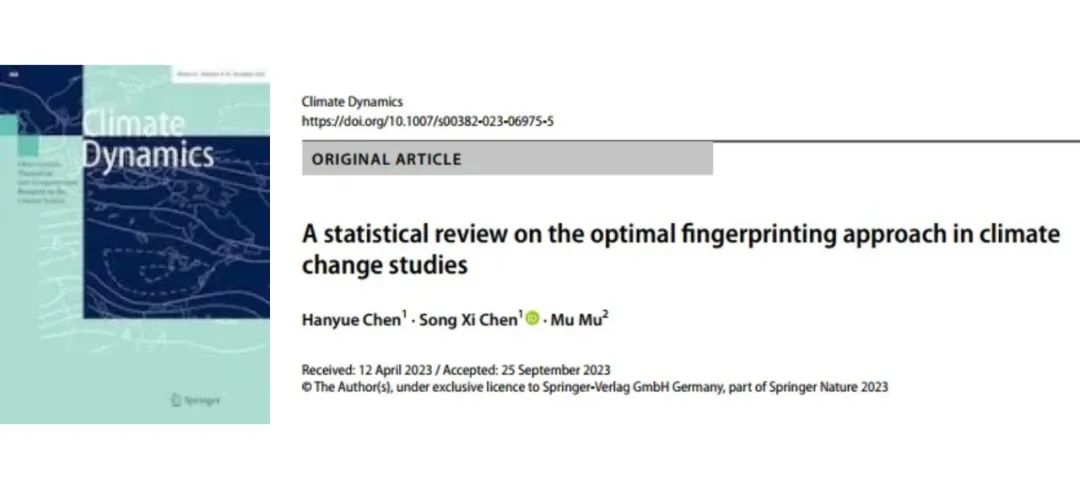A statistical review on optimal fingerprinting method published in Climate Dynamics.
The paper “A Statistical Review on the Optimal Fingerprinting Approach in Climate Change Studies” by Hanyue Chen (Ph.D. Student at Center for Statistical Science, Peking University), Professor Song Xi Chen (Center for Statistical Science, Peking University) and Professor Mu Mu (Department of Atmospheric and Oceanic Sciences, Fudan University ) has recently been published in Climate Dynamics at https://link.springer.com/article/10.1007/s00382-023-06975-5. Climate Dynamics is a significant journal in climate change studies. In this work, we review the optimal fingerprint method widely used in climate change research from statistical perspectives, basically affirm the statistical basis of the method, and state that the unbiased and consistent fingerprinting statistics can be obtained under routine conditions, but its optimality can only be achieved under ideal conditions (the residual covariance matrix simulated by climate models coincides with the internal variability of the real climate system), and also points out the potential challenges of high-dimensional data at high resolution. This paper could help researchers better understand the statistical basis and effective application of the optimal fingerprinting approach in climate change studies.

The optimal fingerprinting approach was first proposed by the 2021 Nobel Prize winner Klaus Hasselmann. The linear regression perspective of this method, proposed in a series of papers starting from Allen and Tett (1999) (hereinafter AT99) followed by Allen and Stott (2003) and Stott et al. (2003), has been the cornerstone in the detection and attribution of climate change due to human activities in the last 20 years, and has been the adopted method by numerous Intergovernmental Panel on Climate Change (IPCC) reports on the climate change. It involves regressing observed climate variables on the expected climate responses to external forcings, first pre-whitening the original data with climate model simulated covariance matrix and then achieving optimality by Gauss-Markov (GM) theorem.
Our paper provides a statistical review of the “optimal fingerprinting” approach in AT99 from a point of view of statistical inference in light of the recent acute criticism of McKitrick (2022) (hereinafter M22) . McKitrick’s criticism argues that the “optimal fingerprinting” approach is flawed because it “cannot satisfy the GM conditions" and “did not formally state the null hypothesis of the residual consistency test”. Our review finds that the “optimal fingerprinting” approach would survive much of McKitrick’s criticism under two conditions: (i) the null simulation of the climate model is independent of the physical observations and (ii) the null simulation provides consistent estimation of the residual covariance matrix of the physical internal variation, both depend on the conduction and quality of the climate models. If the latter condition fails, the fingerprinting estimator would still be unbiased and consistent under routine conditions but losing the “optimal” aspect of the approach. The residual consistency test suggested by Allen and Tett (1999) is valid for checking the agreement between the residual covariances of the null simulation and the physical internal variation under certain conditions. However, the testing statistic is not exactly ![]() distributed but asymptotically. We further stated that the Feasible Generalized Least Square method, much advocated by M22, is not regarded as operational by geophysicists, since climate variability has a fairly complex structure which is difficult to be represented by a simple space-time structure and needs to be simulated by climate models, which also brings high-dimensional issues.
distributed but asymptotically. We further stated that the Feasible Generalized Least Square method, much advocated by M22, is not regarded as operational by geophysicists, since climate variability has a fairly complex structure which is difficult to be represented by a simple space-time structure and needs to be simulated by climate models, which also brings high-dimensional issues.
The framework of AT99 has been extended to more general settings of fingerprint detection and attribution studies including errors in the variables (Allen and Stott, 2003). As these works are very much based on the pre-whitening rotation method advocated in AT99, that tries to use the Gauss-Markov theorem for optimality, our comments on and repairs to AT99 are applicable to these works as well.
The first author is Hanyue Chen, Ph.D. student at Center for Statistical Science. Peking University, Professor Song Xi Chen and Professor Mu Mu are the corresponding authors. The study was supported by the National Natural Science Foundation of China.